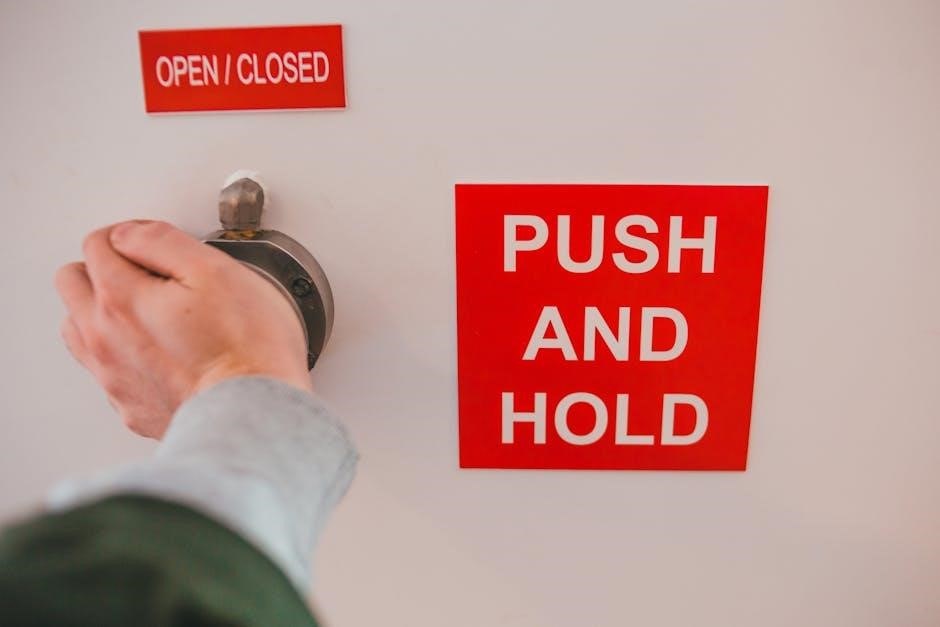1.1 Overview of the Silent Knight 5207 Control Panel
The Silent Knight 5207 is an 8-zone fire alarm control panel with a digital communicator‚ designed for reliable fire protection in commercial settings.
1.2 Importance of the User Manual
This manual provides essential installation‚ programming‚ and operational guidance for the Silent Knight 5207‚ ensuring compliance with safety standards and optimal system performance.
1.3 Target Audience
The manual is intended for technicians‚ engineers‚ and security personnel involved in installing‚ maintaining‚ and operating the Silent Knight 5207 fire alarm system.
The Silent Knight 5207 is a powerful fire alarm control panel designed for commercial and industrial applications. It supports up to 176 addressable devices and offers advanced features like distributed intelligence and modular design. The panel is compatible with a wide range of detectors and modules‚ ensuring flexibility in system configuration. Its intuitive interface simplifies operation‚ while robust programming options enable customized system settings. The 5207 is built for reliability and scalability‚ making it a trusted solution for fire safety systems in various environments.
The user manual is essential for understanding the Silent Knight 5207 control panel’s functionality‚ ensuring proper installation‚ operation‚ and maintenance. It provides detailed instructions‚ safety precautions‚ and compliance requirements‚ helping users navigate the system confidently. The manual also serves as a reference for troubleshooting common issues and optimizing system performance. By following the guidelines outlined‚ users can ensure reliability‚ safety‚ and adherence to fire safety standards like NFPA 72. It is a critical resource for installers‚ operators‚ and maintainers to maximize the system’s effectiveness and longevity.
The Silent Knight 5207 user manual is designed for individuals involved in the installation‚ programming‚ operation‚ and maintenance of the system. This includes fire safety professionals‚ installers‚ system technicians‚ and building managers. It also serves as a reference for security personnel and end-users who monitor and interact with the system daily. The manual provides essential guidance for ensuring compliance‚ proper configuration‚ and effective troubleshooting. It is particularly valuable for those responsible for maintaining fire safety standards and optimizing system performance in commercial or industrial settings.
System Overview
The Silent Knight 5207 is a flexible and scalable fire alarm control panel designed for small to medium-sized facilities‚ offering reliable performance and advanced features.
2.1 Key Features of the Silent Knight 5207
The Silent Knight 5207 fire alarm control panel offers robust features‚ including support for up to 176 detection points across 22 zones. It is compatible with a wide range of smoke‚ heat‚ and pull stations‚ ensuring comprehensive fire detection. The panel also supports the 5230 remote annunciator for enhanced monitoring and control. With built-in network capabilities‚ it can integrate with multiple panels for large-scale systems. Its advanced programming options and compliance with NFPA 72 standards make it a reliable choice for fire safety applications. Additionally‚ it supports optional modules for expanded functionality and system customization.
2.2 UL Listings and Compliance
The Silent Knight 5207 control panel is UL 864 compliant‚ ensuring it meets rigorous fire safety standards. It is listed under UL fire alarm control panels and accessories‚ specifically for fire protective systems. Compliance with UL standards guarantees the panel’s reliability and performance in emergency situations. Installers must follow UL installation requirements to maintain compliance‚ including proper wiring and component selection. Regular maintenance and testing are also required to uphold UL certification and ensure continuous system reliability.
2.3 NFPA 72 Requirements
The Silent Knight 5207 control panel complies with NFPA 72 standards for fire alarm systems. It meets requirements for inspection‚ testing‚ and maintenance‚ ensuring reliable operation. Specific NFPA 72 chapters‚ such as Chapter 14 for emergency control systems‚ apply to this panel. The system must be installed and programmed according to NFPA guidelines to ensure compliance. Regular testing of alarm signals‚ trouble conditions‚ and communication pathways is mandatory. Refer to the user manual for detailed NFPA 72 compliance procedures and ensure all installations adhere to these fire safety standards for optimal performance and reliability.

Installation
The Silent Knight 5207 installation involves careful planning‚ proper tools‚ and adherence to safety guidelines. Ensure the environment meets specified conditions for optimal system performance.
3.1 Pre-Installation Requirements
Before installing the Silent Knight 5207‚ review the manual thoroughly to ensure compliance with local codes and regulations. Verify the system’s compatibility with existing infrastructure and ensure all necessary tools and materials are available. Conduct a site survey to identify potential installation challenges‚ such as power sources or environmental factors. Gather all required documentation‚ including wiring diagrams and component specifications. Ensure the installation team is trained and equipped to handle the system’s specific needs. Finally‚ confirm that the system’s software and firmware are up-to-date for optimal performance.
3.2 Mounting Options (Surface and Semi-Flush)
The Silent Knight 5207 control panel offers two primary mounting options: surface and semi-flush. For surface mounting‚ use the provided screws to secure the panel to a flat surface‚ ensuring stability and proper alignment. Semi-flush mounting requires the optional trim ring‚ which provides a sleek‚ integrated appearance. Ensure the backbox is installed correctly and the panel sits evenly within the recess. Follow the manufacturer’s guidelines for mounting depth to maintain system functionality and aesthetics. Proper mounting ensures reliable operation and compliance with installation standards.
3.3 Wiring Diagrams and Specifications
The Silent Knight 5207 control panel requires precise wiring to ensure proper functionality. Refer to the provided wiring diagrams for detailed connections‚ including zone inputs‚ outputs‚ and power supply. Use the appropriate wire gauge and type‚ as specified in the manual‚ to prevent signal degradation. Ensure all terminals are securely connected to avoid loose connections‚ which can cause system malfunctions. Follow the recommended wiring practices for proper grounding and isolation of circuits. Adherence to these specifications is critical for compliance with UL standards and optimal system performance.
3.4 Power Supply Connection
The Silent Knight 5207 control panel operates on a 24 VDC power supply‚ requiring a dedicated 20 AAC circuit. Connect the primary power to terminals marked as positive (+) and negative (-) on the panel. Ensure the power supply is appropriately rated for the system’s load‚ including auxiliary devices. Use the correct gauge wire to avoid voltage drop. Battery backup connections are essential for uninterrupted operation during power outages. Properly ground the system to prevent noise interference. Follow the manual’s guidelines for secure connections and verify polarity to avoid damage. Always test the power supply after installation.

Programming
Programming the Silent Knight 5207 involves configuring system settings‚ zones‚ and communication parameters for optimal performance. Follow the manual’s step-by-step guide for accurate setup.
4.1 Basic Programming Steps
Begin by entering the programming mode using the keypad or a programmer’s key. Navigate through the menu using the arrow keys to access system parameters. Set the system date and time‚ and configure basic settings like panel name and location. Define zones by assigning each detector or module to a specific zone number. Ensure all devices are initialized and recognized by the system. Save your configuration periodically to avoid data loss. Exit programming mode and test the system to verify proper operation. Refer to the manual for detailed instructions and shortcuts.
4.2 Zone Configuration (Class A and Class B Zones)
Zone configuration on the Silent Knight 5207 involves designating Class A or Class B zones. Class A zones are typically used for critical areas and require two-way communication‚ while Class B zones are simpler‚ one-way configurations. Use the keypad to assign devices to zones‚ ensuring compatibility with your system design. Class A zones require end-of-line resistors‚ while Class B zones do not. Properly label and test zones to ensure functionality. Refer to the manual for specific wiring and configuration instructions to meet NFPA standards and system requirements.
4.3 Setting Up Communication Parameters
Setting up communication parameters ensures the Silent Knight 5207 operates effectively with monitoring systems. Configure IP‚ cellular‚ or dial-up communication methods based on system requirements. Enter the IP address‚ port‚ and account details for IP communication. For cellular‚ select the provider and SIM card settings. Dial-up requires phone line configuration and modem settings. Ensure compatibility with central station receivers. Test communication paths post-configuration to confirm connectivity. Refer to the manual for specific settings and troubleshooting guidance to maintain reliable monitoring and reporting functionality.
4.4 Using the 5230 Remote Annunciator
The 5230 Remote Annunciator enhances system monitoring by providing remote access to alarms‚ troubles‚ and system status. Connect it to the Silent Knight 5207 via a compatible communication link. The 5230 features an LED display and keypad for interactive control. Program the annunciator to mirror the 5207’s zones and events. Use it to acknowledge alarms‚ silence notifications‚ and perform basic system tests. Ensure proper configuration in the 5207’s programming menu to enable remote functionality. Regularly test the connection to maintain reliable operation and ensure seamless communication between devices.

Operation
The Silent Knight 5207 operates by continuously monitoring connected devices‚ responding to alarms‚ and providing real-time system status updates. Follow manual guidelines for smooth functionality and regular system checks.
5.1 Normal Operation and Monitoring
During normal operation‚ the Silent Knight 5207 continuously monitors all connected devices‚ ensuring system readiness. Status LEDs indicate real-time conditions‚ while the keypad provides intuitive access to system information. Regular checks involve verifying zone functionality‚ signal strength‚ and battery levels. The system performs automated self-tests to ensure reliability. Monitoring includes tracking alarm history and trouble conditions‚ enabling proactive maintenance. Follow the manual for proper operation procedures to maintain system integrity and ensure compliance with safety standards. Regularly review the system’s status to prevent potential issues and ensure uninterrupted protection. Always refer to the manual for detailed monitoring guidelines.
5.2 Alarm and Trouble Conditions
The Silent Knight 5207 detects alarm and trouble conditions through connected devices‚ providing clear visual and audible alerts. Alarm conditions trigger the activation of horns‚ strobes‚ or other notification appliances. Trouble conditions indicate system issues‚ such as faulty zones or low battery levels. The control panel displays specific codes or messages for each condition‚ guiding users or technicians to resolve issues promptly. Regular reviews of these conditions ensure system reliability and compliance with safety standards. Refer to the manual for detailed troubleshooting steps and responses to specific alerts.
5.3 Silencing and Resetting Alarms
To silence an alarm on the Silent Knight 5207‚ press and hold the Acknowledge button until the alarm stops. For resetting‚ ensure the system is safe and all alarm conditions have been addressed. Reset the panel by entering the correct user code or using the reset function. Note that resetting does not clear trouble conditions‚ which must be resolved separately. Always verify the system returns to normal operation after silencing or resetting. Refer to the manual for detailed reset procedures and ensure compliance with local fire safety regulations.

Maintenance and Troubleshooting
Regularly inspect wiring‚ check battery health‚ and verify system functionality. Address error codes promptly‚ clean components‚ and test communication pathways to ensure optimal performance and compliance with NFPA 72 standards.
6.1 Routine Maintenance Tasks
Perform monthly inspections of the control panel‚ including battery voltage checks and wiring connections. Clean the panel and components regularly to prevent dust buildup. Test all zones and devices to ensure proper functionality. Check the event log for recurring issues and address them promptly. Verify that all communication pathways‚ such as phone lines or network connections‚ are operational. Replace batteries annually or as indicated by low-battery signals. Ensure the system software is up to date. Test the remote annunciator connection and functionality. Regular maintenance ensures reliable system performance and compliance with safety standards.
6.2 Common Issues and Solutions
Common issues with the Silent Knight 5207 include power-related problems‚ communication failures‚ and zone troubleshooting. If the panel does not power on‚ check the circuit breaker and battery connections. For low battery warnings‚ replace the battery with the recommended type. If the remote annunciator loses connection‚ verify wiring and reset the communication settings. For zone issues‚ inspect wiring for shorts or opens and ensure devices are properly connected. Address false alarms by cleaning smoke detectors and ensuring proper zone configuration. Refer to the troubleshooting guide for detailed solutions to resolve these issues effectively.
6.3 Battery Maintenance and Replacement
Regular battery maintenance is crucial for reliable operation. Inspect batteries every six months for corrosion or damage. Replace batteries annually or when the system indicates low battery levels. Use the recommended 12V‚ 12Ah lead-acid batteries. Disconnect power before replacement to avoid system damage. Clean terminals with a wire brush to ensure proper connections. Dispose of old batteries according to local regulations. Proper maintenance ensures continuous power during outages and prevents false alarms. Always test the system after battery replacement to confirm functionality.

Compatible Products and Accessories
- Model 5210 Zone Expander for additional zones.
- Model 5220 Direct Connect Module for remote control.
- Model 4180 Status Display for enhanced monitoring.
7.1 Model 5210 Zone Expander
The Model 5210 Zone Expander is a compatible accessory for the Silent Knight 5207 control panel‚ designed to increase the system’s zone capacity. It supports up to 8 additional zones‚ allowing for expanded fire detection coverage. The expander is compatible with both Class A and Class B wiring configurations‚ offering flexibility for various installations. It is powered directly from the 5207 control panel‚ simplifying installation. The 5210 also features LED status indicators for real-time zone monitoring. It is UL-listed and designed to meet NFPA 72 requirements‚ ensuring reliable performance. This accessory is ideal for systems requiring additional zone management capabilities.
7.2 Model 5220 Direct Connect Module
The Model 5220 Direct Connect Module is an accessory designed for seamless integration with the Silent Knight 5207 control panel. It enables direct connection of monitoring and control devices‚ supporting up to 8 relay outputs or 8 monitored inputs. The module is UL-listed and complies with NFPA 72 standards‚ ensuring reliability and safety. Its compact design simplifies installation‚ and LED status indicators provide real-time feedback. The 5220 is ideal for systems requiring direct monitoring and control of external devices‚ enhancing the overall functionality of the fire alarm system.
7.3 Model 4180 Status Display Module
The Model 4180 Status Display Module provides a clear and intuitive way to monitor the Silent Knight 5207 control panel’s status; Featuring a backlit LCD display‚ it shows real-time information such as active zones‚ alarm conditions‚ and system messages. The module includes LED indicators for visual alerts and supports up to 16 zones. UL-listed and compatible with the 5207‚ it enhances system visibility and simplifies troubleshooting. Its compact design allows for flexible installation‚ making it an ideal choice for central monitoring stations or areas requiring constant system oversight.

Agency Listings and Requirements
The Silent Knight 5207 meets rigorous UL standards and holds listings for fire alarm systems. Compliance with UL 864 and local regulations ensures reliable performance and safety.
8.1 UL Requirements for Installation
Installation of the Silent Knight 5207 must comply with UL 864 standards. Ensure proper wiring and power supply connections‚ adhering to NEC guidelines. Maintain correct spacing between components to prevent overheating. Regular inspections by authorized personnel are required to verify compliance. Follow UL recommendations for mounting and grounding to ensure system reliability and safety. Compliance with these requirements guarantees optimal performance and adherence to fire safety regulations. Always refer to the UL certification guide for detailed installation protocols. Proper installation is critical for maintaining system integrity and ensuring compliance with fire safety standards.
8.2 California Fire Marshal (CFM) Approval
The Silent Knight 5207 must meet California Fire Marshal (CFM) approval standards. Installation must comply with CFM regulations‚ including proper system testing and documentation. Ensure all components are installed per State Fire Marshal (SFM) listings. Adhere to California-specific fire codes and standards for system operation and maintenance. Proper labeling and certification are required to ensure compliance. Regular system inspections and testing must be documented and maintained. Compliance with CFM approval ensures the system meets stringent state fire safety requirements and operates reliably in emergency situations. Always verify local regulations for specific installation and operational guidelines.

Environmental Specifications
The Silent Knight 5207 operates effectively within specific environmental conditions. Ideal performance occurs at temperatures between 32°F (0°C) and 120°F (49°C) and humidity levels below 90%. Proper ventilation and protection from condensation are essential to maintain system reliability and functionality. Ensure the control panel is installed in a dry‚ secure location to prevent water damage and ensure optimal performance. Adherence to these specifications guarantees long-term system integrity and reliability in various environments.
9.1 Temperature and Humidity Requirements
The Silent Knight 5207 control panel is designed to operate within specific environmental conditions. The system functions optimally in temperatures ranging from 32°F (0°C) to 120°F (49°C)‚ with ideal performance between 60°F (15°C) and 90°F (32°C). Humidity levels should not exceed 90% RH (relative humidity) to prevent condensation and ensure reliable operation. Extreme temperatures or humidity fluctuations may affect system performance‚ so it is crucial to install the panel in a controlled environment. Proper placement ensures long-term reliability and compliance with operational specifications.
9.2 Avoiding Condensation and Water Damage
To prevent damage to the Silent Knight 5207 control panel‚ avoid exposing it to condensation or water. Ensure the panel is installed in a dry‚ well-ventilated area‚ away from direct water sources or high-moisture environments. Avoid placing the unit in basements‚ attics‚ or areas prone to water leaks. Use a weatherproof enclosure if the panel is exposed to outdoor conditions. Regularly inspect the system for signs of moisture buildup and address any issues promptly to maintain system integrity and performance. Proper precautions will ensure long-term reliability and prevent costly repairs.

Reporting and Communication
The Silent Knight 5207 supports advanced reporting and communication features for real-time system monitoring. It enables email notifications for critical events‚ daily/weekly test reports‚ and remote system access.
10.1 Digital Communicator Setup
The Silent Knight 5207 digital communicator enables remote monitoring and reporting of system events. To set it up‚ configure the IP address‚ subnet mask‚ and gateway. Ensure the communicator is connected to a reliable network. Assign a unique identifier and set up user credentials for remote access. Configure communication protocols such as TCP/IP or UDP. Test the connection to verify data transmission. Refer to the manual for specific port numbers and encryption settings. Proper setup ensures seamless communication and reliable system monitoring. Follow manufacturer guidelines to avoid configuration errors and ensure compliance with security standards.
10.2 Dialer and Phone Line Configuration
Configure the dialer to connect the Silent Knight 5207 to a phone line for remote alerting. Connect the phone line to the designated terminal on the control panel. Program the dialer with the monitoring station’s phone number and account details. Set the communication format (e.g.‚ Contact ID or SIA). Ensure the phone line is active and test the connection. Verify that the system can send signals successfully. Refer to the manual for specific dialer settings and troubleshooting common issues like no dial tone or failed connections. Proper configuration ensures reliable emergency communication and compliance with NFPA 72 standards.

Security and Access Control
Protect the Silent Knight 5207 system with secure access controls. Set up user codes and access levels to ensure authorized access. Enable encryption for data integrity and system protection.
11.1 User Codes and Access Levels
The Silent Knight 5207 supports multiple user codes with customizable access levels. Administrators can assign unique codes to users‚ ensuring only authorized personnel can perform specific functions. Access levels range from basic monitoring to advanced system configuration‚ allowing tailored permissions. This feature enhances security by restricting critical operations to designated individuals. Regularly updating user codes and access levels is essential for maintaining system integrity and preventing unauthorized access. Proper management of these settings ensures compliance with security protocols and safeguards the system from potential breaches.
11.2 Protecting System Integrity
To maintain the Silent Knight 5207’s reliability and security‚ ensure the control panel is installed in a secure‚ dry location with stable power. Use a high-quality UPS and surge protector to prevent damage from power fluctuations. Regularly inspect wiring and connections to avoid malfunctions. Keep firmware updated to the latest version‚ as outdated software can introduce vulnerabilities. Always follow manufacturer guidelines for environmental conditions and maintenance. Implement physical security measures‚ such as locking the panel‚ to prevent unauthorized access. Regular system audits and updates are crucial for sustaining performance and security.
12.1 Final Tips for Optimal Use
For optimal performance‚ regularly inspect and maintain the system‚ ensuring all components function correctly. Train users on basic operations and troubleshooting to enhance responsiveness. Schedule routine maintenance checks and keep the user manual handy for quick reference. Familiarize yourself with local fire codes and update software as needed. By following these guidelines‚ you can ensure the Silent Knight 5207 operates reliably‚ providing consistent fire protection and peace of mind for years to come.
12.2 Resources for Further Assistance
For additional support‚ refer to the official Honeywell website for updated manuals‚ FAQs‚ and software tools. Contact Silent Knight technical support directly via phone or email for specialized assistance. Enroll in Honeywell’s training programs or webinars to enhance your knowledge. Join online forums and communities for peer-to-peer troubleshooting. Lastly‚ consult local fire safety authorities to ensure compliance with regional regulations. These resources ensure comprehensive support for optimal system performance and adherence to safety standards.
